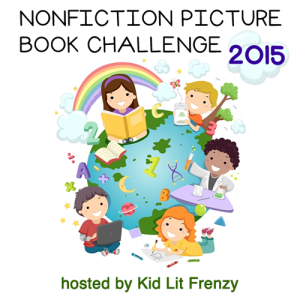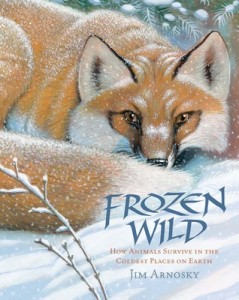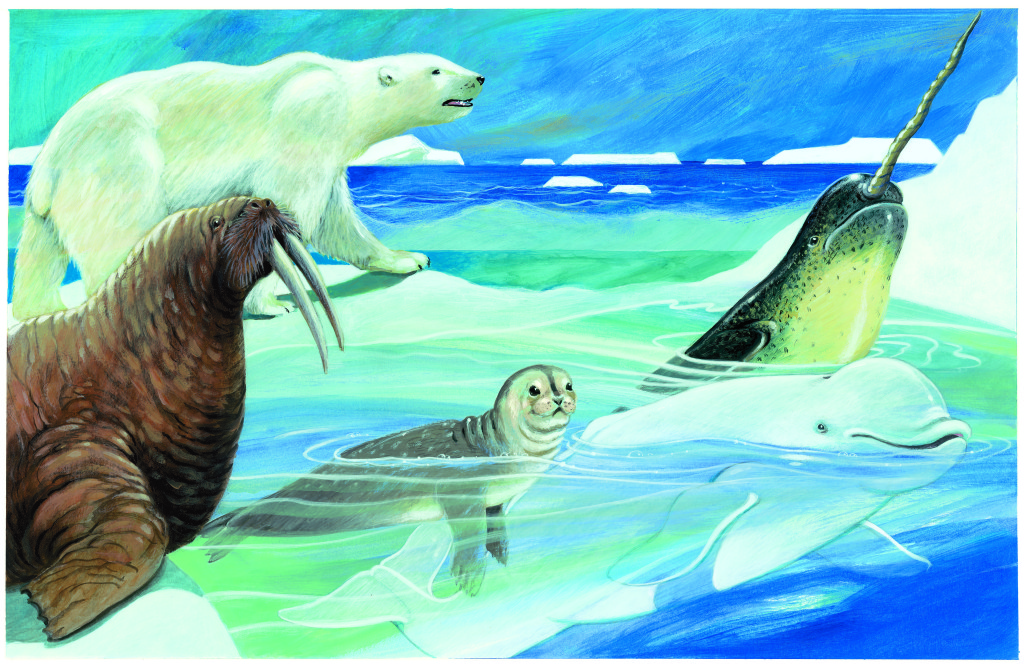Nonfiction Picture Book Wednesday
Nonfiction Picture Book Wednesday is hosted by Kid Lit Frenzy and was started to help promote the reading of nonfiction texts. Most Wednesdays, we will be participating and will review a nonfiction text (though it may not always be a picture book).
Be sure to visit Kid Lit Frenzy and see what other nonfiction books are shared this week!
Frozen Wild: How Animals Survive in the Coldest Places on Earth
Author and Illustrator: Jim Arnosky
Published September 1st, 2015 by Sterling Children’s Books
Goodreads Summary: Quietly it comes—the dark and chill of winter. And in the snow-covered fields and forests, the great northern plains, vast stretches of frozen tundra, and icy polar regions, wild animals have to survive day after day, night after night, out in the cold. How do they do it? Kids can bundle up and join award-winning author, illustrator, and naturalist Jim Arnosky as he follows the tracks of otters, beavers, moose, polar bears, killer whales, penguins, fur seals, and other creatures to discover more about their lives during this frigid season. Arnosky’s stunning art includes five magnificent foldouts that reveal worlds under the ice and at the farthest, frostiest reaches of the globe.
Kellee’s Review: This was my first exposure to Arnosky’s work, and I truly enjoyed my first book by him (and I will definitely be finding more by him). What stood out to me first is that the book was organized very thoughtful and in a way that students will definitely find user friendly. I was then automatically blown away by the artwork. Jim Arnosky is truly an artist. All the illustrations were created using pencil and paint, and they are so realistic and beautiful. Then within each section, the facts that Arnosky choose to share are interesting, well researched, and support the illustrations perfectly. I also really liked the fold outs that expanded the illustrations to sometimes double the size possible without the fold out. Overall, the text is fact-checked and interesting and the illustrations were pieces of artwork.
Ricki’s Review: I knew this book was going to be a great read before I opened the first page. Kellee messaged me to tell me how much she liked it. We review a lot of books together each year, and we only message each other when we really, really like a book. I waited until I had a quiet time to fully immerse myself in the book. The beautiful artwork quickly enveloped me in the winter wildlife. I imagined Arnosky sitting beside his own photographs (which he used as references) to recreate the beauty of the wild. There is so much fantastic information in this text, and Aronsky presents the facts in an accessible way. I can’t wait until my son is a bit older because I know he will really enjoy reading it. It would make a great gift for a child who loves wildlife or wants to learn more about the coldest places on Earth.
Teachers’ Tools for Navigation: Frozen Wild, and the other books in his animal series, are made for classrooms. They can be used in may different ways. My first thought, beside having the book in classroom and school libraries, is using Arnosky’s books as a basis for lit circles where each group would have one of his books. They can use his book, his resources, and other resources to research the topic of each of his books. They then can do an inquiry project using all of their research.
Discussion Questions: What are some of the ways that animals stay warm during the winter?; What is the difference between the Artic and the Antarctic?; What are some ways that animals find food when it is cold?; Which animal do you think is made the best for surviving in the cold?
Author Q&A:
Unleashing Readers: Frozen Wild is the newest book in your animal series. How do you choose the topics for each of your texts?
Jim Arnosky: Frozen Wild is my 137th book about wild animals and wild places. It is the newest book in my series of gatefold books for Sterling. The topics of these books came from either my own curiosity about certain groups of animals or from a suggestion on the part of my editor, Meredith Mundy, to have a book featuring a particular animal. When I work on a suggested topic (which has been rare) my job is to make that book reflect my own personality, viewpoint, experience, and research. That is the crux of being an author. Not just to pass along information, but to share any and all of your understanding gained in thinking about and studying the subject.
UR: How do you choose which animals to include in your books, and what is your research process for your books?
JA: For Frozen Wild my process began with the animals around our farm in Northern Vermont whose tracks I follow all through our snow season. From there the book’s content expanded to my curiosity about the animals who live in places where cold weather can last most of the year. While portions of Frozen Wild were researched in books and conversations I’ve had with friends who have studied animals in these cold regions, and some of the book’s paintings were done from captive species in zoos, most of the time I research my books in the field with Deanna my wife. She photographs the animals while I videotape them.
The video allows me to study animal sounds, anatomy, movement, and behavior long after we have returned home. And Deanna’s still photos provide yet another viewpoint of the subjects I write about and paint.
UR: What is your art process?
JA: For the painting, I sketch the scenes in pencil on my paper. Then I over- paint the sketch with a layer of acrylic colors, using colors that blend with portions of the scene. On this underpainting of various color area, I re-sketch the scene in white chalk, and then paint the next layer, blocking out the figures and the background. Layer after layer, I build a deeply colored picture that, if you look at the originals with a magnifying lens as I do while I detail the art, you can actually see the multiple layers of color one on top of the other, the first to the top layer. It always thrills me to see that physical dimensional quality of what I have done.
UR: Are there any nonfiction authors or illustrators that influence you?
JA: My favorite authors are the singer-songwriters such as Bob Dylan, John Denver, James Taylor, Jimmy Buffett, and Joni Mitchell. We did not have books in our home while I was growing up. And our little school had no library to speak of. Later, I found favorite authors in the great books – Thor Heyerdahl’s Kon Tiki, Ernest Hemingway’s The Old Man and the Sea, Mark Twain, John Burrough (the great naturalist) Henry Benston, Aldo Leopold, and Hal Borland.
My favorite illustrators (and painters) are Bruno Liljefors, Bob Kuhn, N.C. Wyeth, Roger Tory Peterson, Audubon, Charles Tunniclyfe, Ernest Thompson Seton, and Winslow Homer.
I am self taught in both art and nature and have learned much about art from studying these great masters. Also, I have met and learned from many great naturalists and scientists who have been generous in sharing their knowledge with me.
UR: Any plans for the next book in the series?
JA: Presently I am working with Starwalk Kids Media in bringing my popular Crinkleroot series of nature guides into the digital realm. I am also working on another picture book. I have a novel making the rounds and have just finished a picture book about the invasive species problem threatening our wildlands. It is called Wild Invaders. For the Sterling series, our next book will be about animal camouflage.
Thank you for your interest in my work! I am happy to Skype a conversation with you if you wish. Deanna (jarnosky@fairpoint.net) can set that up. Also for further info please go to my website (www.jimarnosky.com) There is a piece in there describing Deanna and my early days in the can where, living basically, I was able to find my way into nature and writing and illustrating books. It is called “Born In A Tree – A Natural History”.
We are seeing color change now. And the air is getting cooler. Soon winter will be upon us again.
Your friend in books, Jim Arnosky
We Flagged:
Read This If You Loved: Winter Bees & Other Poems of the Cold by Joyce Sideman and Rick Allen, Firefly July by Paul Janeczko, Feathers by Melissa Stewart, Born in the Wild by Lita Judge, Forest Has a Song by Amy Ludwig VanDerwater, Over and Under Snow by Kate Messner, Seymour Simon animal books and extreme series
Recommended For:
Giveaway!
What to know more about the book? Check out Mrs. Knott’s Book Nook!
**Thank you to Joshua at Sterling Publishing for providing copies for review and the giveaway!**







Jim Aronsky is one of my most favorite nature illustrators. Little Burro, especially, is a simple story of a little burro who makes his first excursion through the Arizona desert to a lake with his mother and some others. It’s charming, timeless, and authentic. Aronsky said he conceived the book after actually watching some wild burros near an Arizona lake. The desert colors are amazing, and much is learned about the desert ecosystem as well.
Thank you for introducing me to Little Burro. I will definitely try to find it.
Here is a link to my blog post earlier this year that features other beautiful books by Jim Arnosky: http://arepreading.tumblr.com/post/117685931881/janature. Don’t miss one of my favorites: Thunder Birds.
Thank you for sharing this! I am so interested in reading more of his texts!
This looks like a lovely book. Jim Arnosky is a great author to go to for nonfiction texts. I hadn’t realized he’s written that many books. I like the idea of using his books for lit circles. It’s a great way to bring nonfiction to lit circles.
I knew Arnosky was a prolific illustrator, but I had no idea how prolific – “Frozen Wild” is his 137th book about wild animals and wild places? That’s pretty impressive – I’d be thrilled to get a single book out there in my lifetime, especially one that finds its way into school libraries! 🙂
Oh wow, Frozen Wild once again! It does sound like a very special book. Thanks for sharing!